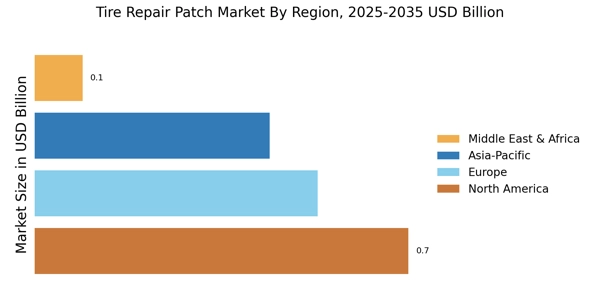Increasing Vehicle Ownership
The rising trend of vehicle ownership appears to be a primary driver for the Tire Repair Patch Market. As more individuals acquire vehicles, the demand for maintenance products, including tire repair patches, is likely to increase. In many regions, vehicle ownership rates have shown a steady upward trajectory, with statistics indicating that the number of registered vehicles has grown significantly over the past few years. This trend suggests that more consumers will require tire repair solutions, thereby expanding the market for tire repair patches. Furthermore, as vehicles age, the likelihood of tire damage increases, which could further bolster the demand for effective repair solutions. Consequently, the Tire Repair Patch Market is poised to benefit from this growing consumer base, as vehicle owners seek reliable and cost-effective methods to maintain their tires.
Rising Awareness of Road Safety
The heightened awareness surrounding road safety is influencing the Tire Repair Patch Market positively. As consumers become more conscious of the importance of maintaining their vehicles in optimal condition, the demand for tire repair solutions is expected to rise. Educational campaigns and government initiatives aimed at promoting road safety have led to an increase in consumer knowledge regarding the risks associated with tire damage. This awareness encourages vehicle owners to invest in tire repair patches as a preventive measure. Moreover, statistics indicate that a significant percentage of road accidents are attributed to tire-related issues, which further emphasizes the need for effective tire maintenance solutions. As a result, the Tire Repair Patch Market is likely to experience growth driven by this increasing focus on safety and maintenance.
Growth of the Automotive Aftermarket
The expansion of the automotive aftermarket is significantly impacting the Tire Repair Patch Market. As consumers increasingly seek to maintain and repair their vehicles rather than replace them, the demand for aftermarket products, including tire repair patches, is likely to grow. Market analysis indicates that the automotive aftermarket has been experiencing robust growth, driven by factors such as rising vehicle age and a shift towards DIY maintenance. This trend suggests that consumers are more inclined to purchase repair solutions to extend the lifespan of their tires. Additionally, the proliferation of online platforms for purchasing automotive products has made it easier for consumers to access tire repair patches. Therefore, the Tire Repair Patch Market is well-positioned to capitalize on this trend, as more vehicle owners turn to aftermarket solutions for tire maintenance.
Environmental Concerns and Sustainability
The increasing focus on environmental sustainability is becoming a significant driver for the Tire Repair Patch Market. As consumers and manufacturers alike prioritize eco-friendly practices, the demand for sustainable tire repair solutions is likely to rise. Many tire repair patches are now being developed with environmentally friendly materials, which appeal to a growing segment of eco-conscious consumers. Market trends indicate that products designed with sustainability in mind are gaining popularity, as they align with broader consumer values regarding environmental responsibility. Furthermore, regulatory pressures aimed at reducing waste and promoting recycling are encouraging manufacturers to innovate in this space. As a result, the Tire Repair Patch Market is expected to benefit from this shift towards sustainability, as consumers increasingly seek out products that reflect their commitment to environmental stewardship.
Technological Innovations in Repair Solutions
Technological advancements in tire repair solutions are emerging as a crucial driver for the Tire Repair Patch Market. Innovations such as self-adhesive patches and advanced materials that enhance durability and effectiveness are gaining traction among consumers. These developments not only improve the efficiency of tire repairs but also reduce the time and effort required for application. Market data suggests that the introduction of these innovative products has led to a notable increase in consumer adoption rates. As manufacturers continue to invest in research and development, the availability of high-quality tire repair patches is expected to expand, catering to a diverse range of consumer needs. Consequently, the Tire Repair Patch Market stands to benefit from these technological advancements, as they enhance product appeal and performance.


















Leave a Comment